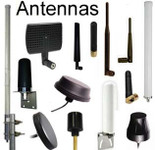- Home
- Antennas, Antenna Cables, Wireless Products: Technical Articles
Antennas, Antenna Cables, Wireless Products: Technical Articles
How to Measure and Improve RSSI for Antennas and IoT Devices
George Hardesty
Antennas | IoT - Internet of Things
April 13th, 2025
6 minute read
Measuring and improving RSSI for your antennas and IoT devices involves both hardware-based adjustments and software monitoring techniques. Let's break it down into Measurement and Improvement.
1. Measuring RSSI
Tools & Methods for Measuring RSSI
IoT Devices Built-in RSSI Readings:
- Many IoT devices and modules (e.g., Wi-Fi modules, LoRaWAN nodes, Zigbee devices) provide RSSI readings as part of their status reports.
- Example (LoRaWAN device):bash
AT+RSSI? # Command to check RSSI on a LoRa module - Example (Wi-Fi):bash
iwconfig # Linux command to show RSSI for connected networks - Example (Bluetooth LE):python
peripheral.read_rssi() # Reading RSSI in Bluetooth Python libraries like PyBluez
Software Tools & Apps:
- Wi-Fi Analyzers: Tools like
Wireshark,Acrylic Wi-Fi Analyzer, orNetSpotprovide detailed RSSI readings for various channels and networks. - Bluetooth Scanners: Apps like
nRF Connect(for Bluetooth Low Energy) provide RSSI values for nearby devices. - LoRaWAN Network Servers: Platforms like The Things Network (TTN) report RSSI for received packets.
- Wi-Fi Analyzers: Tools like
Specialized Hardware Tools:
- Spectrum Analyzers: Provide detailed signal strength analysis across various frequencies.
- RF Signal Meters: Handheld devices specifically designed to measure RSSI for RF antennas.
2. Improving RSSI
Antenna Optimization
Antenna Type Selection:
- For point-to-point links (e.g., LoRaWAN over long distances): Use high-gain directional antennas.
- For general area coverage (e.g., Wi-Fi in a building): Use omnidirectional antennas.
Antenna Positioning & Orientation:
- Raise antennas above obstacles for line-of-sight communication.
- Align directional antennas properly toward receiving devices.
Avoid Signal Interference:
- Move away from metallic objects, which can reflect or block signals.
- Minimize the number of obstacles (walls, furniture, etc.) between transmitter and receiver.
Signal Optimization Through Software Configuration
Adjust Transmission Power:
- Increasing transmission power can improve RSSI, but also consumes more energy (especially important for battery-powered IoT devices).
- Example (LoRaWAN):bash
AT+TXPWR=14 # Setting transmission power to 14dBm - Example (Wi-Fi): Adjusting
TX Powerin router configuration (e.g., 20 dBm, 30 dBm).
Optimize Network Protocols:
- For mesh networks (e.g., Zigbee, Thread): Ensure paths are dynamically optimized by monitoring RSSI.
- For LoRaWAN networks: Adjust
Spreading Factor (SF)andBandwidth (BW)to improve RSSI over long distances.
Hardware Enhancements
- Use RF Amplifiers / Boosters:
- Inline amplifiers can be used to increase signal strength between antenna and device.
- Install Antenna Arrays:
- Using multiple antennas can help improve coverage and signal strength.
- Use High-Quality Cables & Connectors:
- Poor-quality cables/connectors can introduce significant signal loss, reducing RSSI.
Monitoring & Feedback Loop
- Continuous RSSI Monitoring:
- Regularly check RSSI levels and log them over time to identify trends or issues.
- Automated Feedback Systems:
- Create algorithms or scripts to automatically adjust antenna orientation or transmission power based on RSSI readings.
Implementing a Monitoring and Feedback System for RSSI in Your IoT Applications
To build an effective RSSI Monitoring and Feedback System, we'll combine IoT devices, a server or database for logging, and feedback mechanisms to improve signal quality based on RSSI values.
Overview
Hardware Components:
- IoT devices with wireless modules (e.g., LoRa, Zigbee, Wi-Fi, Bluetooth).
- Antennas suitable for your application (omnidirectional, directional, high-gain, etc.).
- Optional: RF amplifiers or signal boosters.
Software Components:
- Data logging server or cloud database (e.g., AWS, Firebase, Local SQL/NoSQL DB).
- Feedback algorithm to adjust antennas or transmission settings based on RSSI readings.
- Dashboard for monitoring and visualization (e.g., Grafana, Node-RED, Custom Web App).
Programming Languages & Tools:
- Python, Node.js, C/C++ (for embedded systems).
- MQTT / HTTP for communication between devices and server.
Step 1: Setting Up RSSI Monitoring on IoT Devices
Example: LoRaWAN Device (ESP32 + LoRa Module)
python
from machine import Pin, SPIimport lora # Assuming a LoRa library for your module
import time
import network # If Wi-Fi is involved
# Configure LoRa module
lora.setup(frequency=915e6, tx_power=14) # Adjust frequency for your region
def read_rssi():
rssi_value = lora.rssi() # Read RSSI value from LoRa module
return rssi_value
while True:
rssi = read_rssi()
print(f"Current RSSI: {rssi} dBm")
# Send RSSI data to server for logging (via MQTT or HTTP)
# mqtt.publish("rssi_topic", str(rssi))
time.sleep(60) # Measure every minute
Example: Wi-Fi Device (ESP8266/ESP32)
python
import networkimport time
def get_rssi():
wlan = network.WLAN(network.STA_IF)
wlan.active(True)
rssi = wlan.status('rssi')
return rssi
while True:
current_rssi = get_rssi()
print(f"RSSI: {current_rssi} dBm")
# Send data to server for monitoring
# mqtt.publish("rssi_topic", str(current_rssi))
time.sleep(60)
Step 2: Logging RSSI Data to a Server
Option 1: Cloud Database (AWS DynamoDB, Firebase)
- Use MQTT or HTTP to send RSSI readings to the cloud.
- Store data with timestamp, device ID, and RSSI value.
Option 2: Local Database (SQLite, InfluxDB)
- Store RSSI readings locally for real-time monitoring.
- Example (Python with SQLite):
python
import sqlite3
conn = sqlite3.connect('rssi_data.db')
cursor = conn.cursor()
cursor.execute('''CREATE TABLE IF NOT EXISTS RSSI_Log
(timestamp TEXT, device_id TEXT, rssi INTEGER)''')
def log_rssi(device_id, rssi_value):
cursor.execute("INSERT INTO RSSI_Log VALUES (datetime('now'), ?, ?)", (device_id, rssi_value))
conn.commit()
log_rssi('Device_1', -68)
conn.close()
Step 3: Visualizing RSSI Data
Using Grafana or Node-RED Dashboard
- Set up a dashboard to visualize RSSI readings over time.
- Display trends and identify weak spots or connectivity issues.
- Set alerts when RSSI falls below a certain threshold.
Step 4: Implementing a Feedback System
Automatic Feedback Algorithm
This algorithm adjusts settings (e.g., transmission power, antenna orientation) when RSSI is poor.
python
import time
LOW_RSSI_THRESHOLD = -80 # Adjust as needed
def adjust_tx_power(current_rssi):
if current_rssi < LOW_RSSI_THRESHOLD:
print("Increasing transmission power...")
# Example: AT command to increase power for LoRa
# lora.send_command("AT+TXPWR=20")
else:
print("Signal is strong enough.")
while True:
rssi = read_rssi()
print(f"RSSI: {rssi} dBm")
adjust_tx_power(rssi)
time.sleep(60)
Step 5: Implementing Antenna Adjustment
Servo Motors for Directional Antennas:
- Use servo motors to physically adjust directional antennas based on RSSI feedback.
- Automatically orient antennas for optimal signal strength.
Automatic Channel Selection:
- For Wi-Fi or Bluetooth, scan available channels and switch to the one with the highest RSSI.
- Example:
iwlist wlan0 scan(Linux command) to check RSSI per channel.
Step 6: Monitoring & Optimizing
- Regularly analyze logs to identify weak areas or patterns of interference.
- Use feedback mechanisms to automatically adjust antenna positioning or transmission power.
- Deploy dashboards and alerts for real-time monitoring.
Related Articles
RSSI & Antenna Performance and IoT Wireless Applications
6 minute read
April 1st, 2025
Beamforming: How Modern Antenna Arrays Improve Connectivity
8 minute read
February 15th, 2025
Wi-Fi HaLow Long-Range Wireless IoT OutPerforms LoRa, NB-IoT
6 minute read
February 14th, 2025







